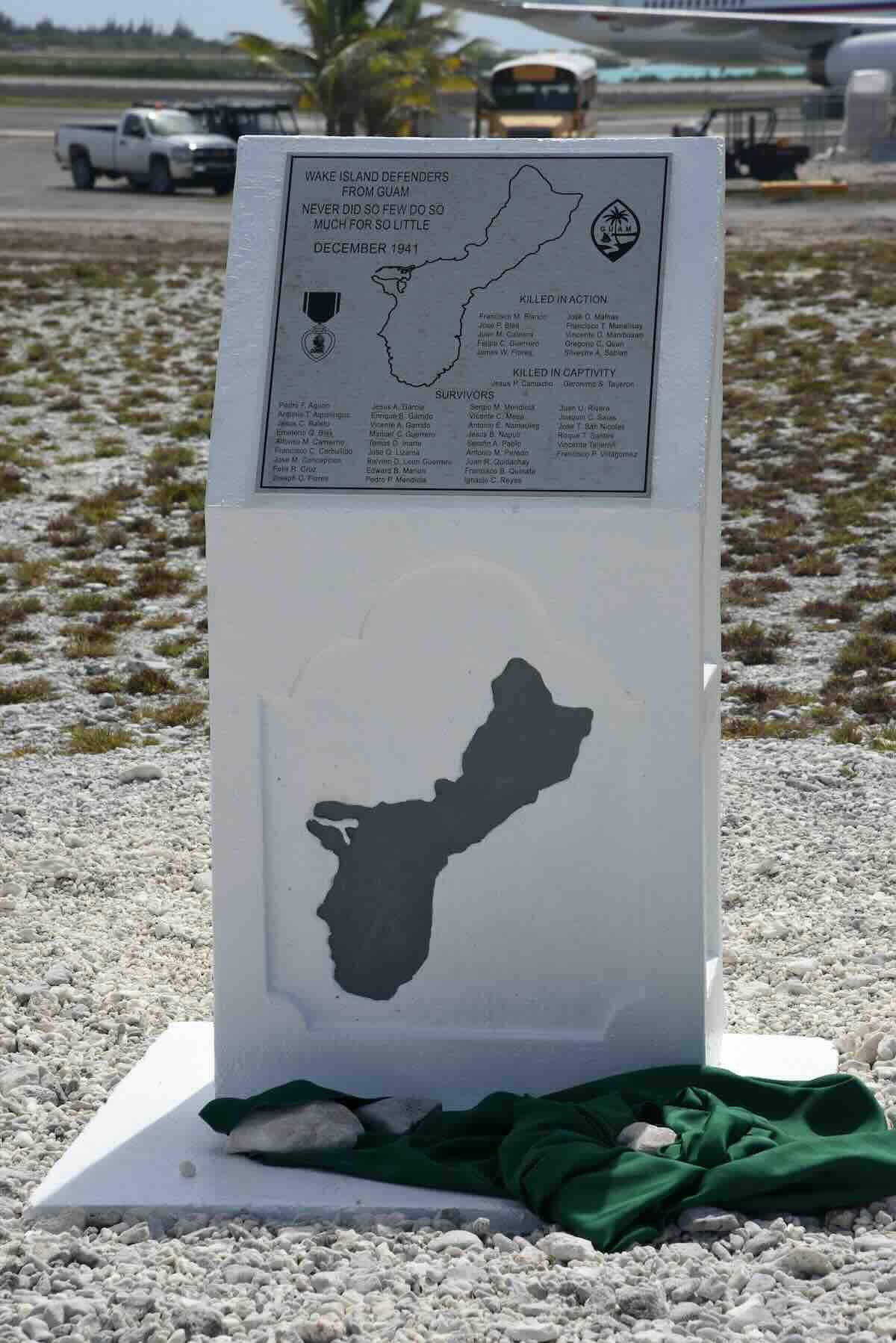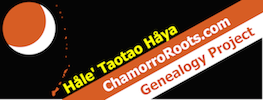Home
Wake Island's Guam Memorial 2017 Rededication
- Details
- Written by: Bernard Punzalan

On June 8 2017, the Pacific Air Forces Regional Support Center and Wake Island’s Detachment 1 leadership paid honor to 45 Chamorros with a rededication ceremony of the Wake Island’s Guam Memorial.
Aguiguan
- Details
- Written by: Bernard Punzalan

Aguiguan is a very difficult and challenging island to access. There are approximately 32 prehistoric sites documented. Prehistoric artifacts recovered on Aguiguan are dated to be as early as the pre-latte period before A.D. 800. However, the archeological evidence also supports the notion that the permanent occupation of Aguiguan likely occurred sometime after A.D. 1000 during the latte period; as also evidenced by the latte sets found on Aguiguan.
Aguiguan was one of the last islands to be conquered by the Spaniards in 1695. Some of the CHamoru people that resided on Tinian even fled to Aguiguan to seek refuge during the CHamoru-Spanish wars. Sadly, in the historical setting of this book, only two CHamorus were named: Maga’låhi Taga (pg.22) and an infant baptized on Aguiguan by Father San Vitores in August 1668 with the name Ignacia (pg.23).
Aguiguan, later, became more frequently referred to as “Goat Island.” Sometime after 1818, the residents of Tinian introduced goats to Aguiguan. Other than for fishing and goat hunting the island was seldomly visited during the Spanish colonization and pretty much silent on information under the German administration.
Under the administrative rule and colonization of the Japanese, they were more aggressive in pursuing economic expansion and opportunities under the sphere of Japan. Workers from Okinawa and laborers from Korea were brought into the Mariana islands to help meet those objectives. Aguiguan was primarily used by the Japanese for cultivating sugar cane fields.
As a result, there are CHamoru people with Okinawan and Korean ancestry from some of these workers/laborers.
In 1943, there were 356 people on Aguiguan. Over 40% were Korean laborers (mostly unmarried), while the remainder were Okinawan workers (some had families).
“Our knowledge of the plantation and plantation life on Aguiguan has been greatly increased by Mr. Joaquin S. Borja of Tinian. Mr. Borja, who kindly consented to be interviewed for this project, lived on Aguiguan as a small boy. He was born in 1936 and was 9 years old when the population was removed in 1945. Mr. Borja not only has his recollections but also a body of information imparted to him by his parents. At the time of the survey Mr. Borja's mother was still living but in ill-health and could not be interviewed. Mr. Borja's father was an Okinawan who married a local woman on Rota, which is where Joaquin was born. The father was later transferred to Aguiguan where he served as one of the winch operators at the landing complex. The family lived in one of the housing units at that site.”
Brian M. Butler.1992. An Archeological Survey of Aguiguan (Aguijan) Northern Mariana Islands.
Website Updates
- Details
- Written by: Bernard Punzalan
I have applied several major required updates to the website. I apologize for any inconveniences that may occur until we are fully functional. Please do let me know if you are experiencing anything unusual. Thanks. ~Bernard
Rain Cloud from Washington State
- Details
- Written by: Bernard Punzalan

Meet Rain Cloud - He stopped by our CHamoru Roots Genealogy booth at the CHamoru Day Festival, June 21, 2025 in Tacoma, Washington and shared with a familiar story related to what I have been recently tracking. He is a Native American with CHamoru Roots.
His mother, a CHamoru, who became an orphaned child on Saipan during the tragedy of World War II. She had siblings, but thinks they too were unfortunately killed on Saipan during the war. She was adopted by an Okinawan family that eventually migrated to the United States. He does not know his mother’s original surname, but she was born in Garapan, Saipan. She recalls being on the island of Yap, but not much else is known about that.
Some historical background that is linked to Rain Cloud’s story…After World War II many of the Japanese, Okinawan and Korean people and their families that were brought in as laborers during the Japanese administration (post-World War I/Japan mandate under the United Nations), were repatriated back to their countries or origin. Granted, some of those Japanese, Okinawan and Korean families were allowed to stay. Also, we are reminded that the Ryuku Islands, which Okinawa was a part of, and the Ogasawara Islands (where you find descendants with CHamoru Roots, but that’s another story), were retained and governed by the U.S. Those islands remained under the administration of the U.S. and were not fully restored back to the the sovereignty of Japan (1971 Okinawa Reversion Agreement) until 1972.
I present this story out here in hopes that more pieces of the puzzle will trickle in to help him find his mother’s long lost family and reconnect him to part of his heritage. Many children were orphaned throughout the entire Mariana Islands during World War II. They and their descendants feel their spirit calling them to learn more of their CHamoru heritage.
Crewman Jose Mendiola
- Details
- Written by: Bernard Punzalan

The first instance we see the name Jose Mendiola, was by Joseph-Paul Gaimard, Surgeon Assistant for the Freycinet’s science expedition in 1819. Mendiola was one of the CHamoru people examined by Gaimard for the dynamometric experiment. Gaimard described Mendiola as a 14-year old, well built young man.
Eight years later, Gaimard is assigned to another French science expedition aboard the Astrolabe. In May 1827, as the Astrolabe was passing through the Lau Islands, south of Fiji, the ship was met by the canoe of a Tongan chief who had with him three "Spanish" castaways who part of the brig Concepcion that shipwrecked on the reefs of Vanua Levu Island, three years previously. Mendiola would have been 17 years old at the time of the shipwreck.
Gaimard immediately recognized one of the castaways as "le jeune Mediola" whom he had known on Guam. Mendiola, 21 years old, stayed on the Astrolabe as a member of the crew and interpreter for the French, for nearly a year until it reached Guam by May 2, 1828. He was honourably discharged. Gaimard settled Mendiola’s account and paid him about 30 piastres, which in those days was considered although small, still a fortune for the Mariana Islands.
Mendiola’s family was surprised and happy to see him alive. After all those years they thought him dead. Mendiola was one of the crew members that fell ill before landing on Guam. He recovered quickly and in appreciation, Mendiola brought Gaimard fruit and poultry. Gaimard only accept oranges and told him to keep the rest for himself. Gaimard was very pleased by Mendiola’s gratitude, and stated that his conduct had always been exemplary.
Bibliography:
Sylvie Brassard and John Milsom. 2025. A Scientific Voyage in the Southern Hemisphere and Around the World Executed Successively on Board the King’s Corvette Uranie and His Majesty’s Corvette La Physicienne During the Years 1817, 1818, 1819 and 1820 Narrative Journal of Joseph-Paul Gaimard Commissioned Surgeon of the Marine Royale Series III VOLUME 44. The Boydell Press. London, England
Rodrigue Levesque. 2003. History of Micronesia: History of Micronesia: Lutke Expedition and First D’Urville Expedition, Volume 22. Levesque Publications. Quebec, Canada
Page 2 of 84

